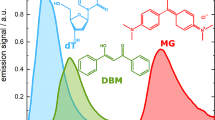Summary
Five basic fluorochromes were evaluated to determine whether or not any could be used in microfluorometric studies for the selective demonstration of nucleic acids. Only two of the fluorochromes-Nuclear Yellow (Hoechst 769121) and the phenoxyindole compound D261/37-were found to be selective for nucleic acids, while the other three fluorochromes produced small to moderate amounts of fluorescence in preparations extracted sequentially with RNase and DNase. All of the fluorochromes could be considered “structural probes” since they produced less fluorescence in the highly condensed chromatin of thymocyte nuclei than they did in the less condensed chromatin of hepatocyte nuclei. When exposed to continuous excitation for 2-min intervals, hepatocyte nuclei stained with Nuclear Yellow or D261/37 gradually lost, respectively, approximately 21% or nearly 60% of their original fluorescence. Nuclei stained with the other three fluorochromes displayed much more rapid fading and lost more than 80% of their original fluorescence.
Similar content being viewed by others
References
Bentivoglio M, Kuypers HGJM, Catsman-Berrevoets CE (1980a) Retrograde neuronal labeling by means of bisbenzimide and Nuclear Yellow (Hoechst 769121). Measures to prevent diffusion of the tracers out of retrogradely labeled neurons. Neurosci Lett 18:19–24
Bentivoglio M, Kuypers HGJM, Catsman-Berrevoets CE, Loewe H, Dann O (1980b) Two new fluorescent retrograde neuronal tracers which are transported over long distances. Neurosci Lett 18:25–30
Cowden RR, Curtis SK (1981) Microfluorometric investigations of chromatin structure. I. Evaluation of nine DNA-specific fluorochromes as probes of DNA organization. Histochemistry 77:11–23
Curtis SK, Cowden RR (1980) Effects of preparation and fixation on three quantitative cytochemical procedures. Histochemistry 68:29–38
Curtis SK, Cowden RR (1981) Four fluorochromes for the demonstration and microfluorometric estimation of RNA. Histochemistry 72:39–48
Gill D (1979) Inhibition of fading in fluorescence microscopy of fixed cells. Experientia 35:400–401
Giloh H, Sedat JW (1982) Fluorescence microscopy: reduced photobleaching of rhodamine and fluorescein protein conjugates by n-propyl gallate. Science 217:1252–1255
Johnson GD, Nogueira Aramjo GMdeC (1981) A simple method of reducing the fading of immunofluorescence during microscopy. J Immunol Methods 43:349–350
Kuypers HGJM, Bentivoglio M, Catsman-Berrevoets CE, Bharos AT (1980) Double retrograde neuronal labeling through divergent axon collaterals, using two fluorescent tracers with the same excitation wavelength which label different features of the cell. Exp Brain Res 40:383–392
Lief RC, Easter HN, Warters RL, Thomas RA, Dunlap LA, Austin MF (1971) Centrifugal cytology. I. A quantitative technique for the preparation of glutaraldehyde-fixed cells for light and scanning electron microscopy. J Histochem Cytochem 19:203–215
Pederson T (1981) Messenger RNA biosynthesis and nuclear structure. RNA: protein particles are sites of messenger RNA processing in the cell nucleus. Am Sci 69:76–84
Rigler R (1966) Microfluorometric characterization of intracellular nuclei acids and nucleoproteins by acridine organge. Acta Physiol Scand 67 (Suppl 267):1–222
Ringertz NR (1969) Cytochemical properties of nuclear proteins and deoxyribonucleoprotein complexes in relation to nuclear function. In: Lima-De-Faria A (ed) Handbook of molecular cytology. American Elsevier, New York, pp 656–684
Schmued LC, Swanson LW, Sawchenko PE (1982) Some fluorescent counterstains for neuroanatomical studies. J Histochem Cytochem 30:123–128
Schnedl W, Mikelsaar A-V, Breitenbach M, Dann O (1977) DIPI and DAPI: Fluorescence banding with only negligible fading. Hum Genet 36:167–172
Swift H (1966) The quantitative cytochemistry of RNA. In: Wied GL (ed) An introduction to quantitative cytochemistry. Academic Press, New York, pp 355–386
Wachtler F, Musil R (1979) Nucleoli visualized by silver staining combined with a new RNA specific fluorochrome. Stain Tech 54:265–268
West SS, Golden JF, Menter JM, Love LD (1976) Quantitation of fluorescence fading phenomena for identifying intracellular biopolymers. J Histochem Cytochem 24:59–63
Wray W, Conn PM, Wray VP (1977) Isolation of nuclei using hexylene glycol. In: Stein G, Stein J, Kleinschmith LJ (ed) Methods in cell biology, vol 16. Academic Press, New York, pp 69–86
Author information
Authors and Affiliations
Rights and permissions
About this article
Cite this article
Curtis, S.K., Cowden, R.R. Evaluation of five basic fluorochromes of potential use in microfluorometric studies of nucleic acids. Histochemistry 78, 503–511 (1983). https://doi.org/10.1007/BF00496202
Accepted:
Issue Date:
DOI: https://doi.org/10.1007/BF00496202



